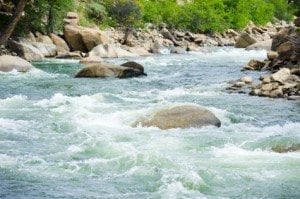MIDWESTERN U.S. HYDRO GENERATION PROFILE, 2013
| State | Conventional Hydro MWh | Total MWh | Total Renewables MWh | Hydro as a % of total | Hydro as a % of renewable | Powered & Non-powered Dams |
|---|---|---|---|---|---|---|
| Illinois | 140,767 | 202,890,600 | 10,439,770 | 0.07% | 1.35% | 1,504 |
| Indiana | 417,297 | 110,377,600 | 4,227,300 | 0.38% | 9.87% | 1,142 |
| Iowa | 667,062 | 56,875,540 | 16,398,060 | 1.17% | 4.07% | 3,374 |
| Kansas | – | 48,645,150 | 9,486,000 | 0% | 0% | 6,087 |
| Michigan | 1,306,871 | 104,969,800 | 6,106,870 | 1% | 17% | 927 |
| Minnesota | 384,241 | 51,262,700 | 10,313,240 | 0.75% | 3.73% | 1,021 |
| Missouri | 1,213,462 | 92,211,140 | 2,452,460 | 1.32% | 49.48% | 5,099 |
| Nebraska | 1,089,026 | 37,196,620 | 2,949,030 | 2.93% | 36.93% | 2,358 |
| North Dakota | 1,852,421 | 35,361,140 | 7,387,420 | 5.24% | 25.08% | 866 |
| Ohio | 520,970 | 136,702,100 | 2,409,370 | 0.38% | 21.60% | 1,577 |
| South Dakota | 4,076,759 | 10,357,950 | 6,764,760 | 39.36% | 60.26% | 2,516 |
| Wisconsin | 1,264,628 | 65,586,620 | 4,494,630 | 1.93% | 28.14% | 1,163 |
Sources: USACE NID, EIA
Hydropower in the Midwest

Of the 28,000 existing dams in the Midwest, those that generate electricity supplied thousands of megawatt hours (MWh) of power to the region in 2013. South Dakota enjoys the highest percentage of hydro in its generation mix, and at more than 4 million MWh, the state produced nearly 40 of its electricity from hydro facilities in 2013.
Project highlight: Consumers Energy
The Midwest was home to the first hydropower plant in America, which was built in Wisconsin in the late 1800s. From those beginnings, hydro has grown into the country’s largest source of renewable power and makes up approximately 7 percent of the total electricity generated in the U.S. each year.
Hydroelectric plants can operate for decades, and there is great potential to increase the amount of clean, reliable and affordable electricity we generate from hydropower by modernizing power plants at existing dams. In the region that saw the birth of this energy source, Consumers Energy is one company investing in the future of hydropower by upgrading its existing facilities.
Consumers provides electricity to more than six million people in Michigan and operates 13 hydroelectric plants along five waterways, enough power to serve about 70,000 customers. In 2008 and 2009, the utility invested in a turbine upgrade at its Hardy Dam located on the Muskegon River. First built in 1930, the installation of a new water turbine on Unit 3 means the unit can now produce 11,400 kW of electricity, an increase from 10,800kW before the upgrade. Hardy now not only produces more power, but produces it in a more sustainable way. The new turbine helps to increase dissolved oxygen levels in the plant’s outflow, which benefits the fish habitat downstream from the dam.
Consumers received a production tax credit (PTC) for the Hardy project. The PTC program is a tax credit awarded to generators of qualifying renewable energy, and hydroelectric facilities like Hardy receive 1.1¢ for each kilowatt hour of electricity they produce.


